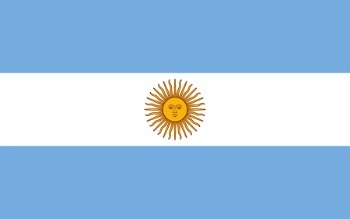THE Argentina flag was created at the time of the country's independence.
It consists of two blue horizontal bands separated by a white horizontal band. In the center is the figure of the sun.

Argentina's official flag
Origin
The author of the current Argentine flag is Manuel Belgrano, one of the independence leaders.
Belgrano commanded troops in the province of Rosario and realizing that soldiers wore different identifications, he proposes that they all wear a blue and white badge.
The use of this symbol was approved by the government of the First Triumvirate of the United Provinces of Rio da Prata, in February 1812.

Manuel Belgrano takes the oath to the soldiers' flag. Author: Juan Peláez, 1910
A few days later, Manuel Belgrano himself designed the first Argentine pavilion in these colors. Belgrano, who was staying at the home of the brothers Vicente and María Catalina Echevarría, asks her to make a flag.
Then, before this standard, he made the troops swear loyalty to the fatherland and fight the Spaniards.
After the wars of independence, the blue and white flag was declared official by the Congress of Tucumán in 1816, just 11 days after Argentina finally defeated Spanish troops.
Meaning
The origins for choosing colors are controversial.
Some interpretations say that Manuel Belgrano would have been inspired by the blue Argentine sky. Likewise, in the colors of the image of Our Lady of Mercy, to whom he was a devotee.
Other sources point out that Belgrano was inspired by the colors of the Spanish Royal Family, the Borbons.
After all, he was a supporter of the idea that the Queen Carlota Joaquina he could form a monarchical government in the country, but independent of Spain.
May sun
In addition to the colors, in the center of the streamer is a sun with a human face, yellow with 32 alternating rays in:
- 16 pointing or turning clockwise;
- 16 straight.
This symbol was included by the then Supreme Director of the United Provinces of Río de la Plata, Juan Martín de Pueyrredón, in 1818, making reference to the 25th of May.
Argentine independence was proclaimed on May 25, 1810 and this day was quite rainy in Buenos Aires.
However, the sun came out and this was interpreted as a good omen for the leaders of the new country. Therefore, the sun is also known as the “Sun of May” (Sun of May, in Spanish).
The design was conceived by the Peruvian goldsmith Juan de Dios Rivera, whose nickname was “The Inca”. It was he who adapted the symbol of Inti, the Inca sun god, as the emblem of the Argentine pavilion.
read more:
- Argentina
- Independence of Spanish America
- Eva Peron
Curiosities
- The Argentine flag is also known as the “white sky”.
- In the city of Rosario, in the province of the same name, there is a monument dedicated to the Argentine flag, inaugurated in 1957.
- Flag Day is celebrated on June 20, the date of Manuel Belgrano's death and is a national holiday.
- To salute the flag, use the aria "high in cielo" or "Song/Prayer a la Bandera", which is part of the opera "Aurora”, by Héctor Panizza.
Also know about other flags:
- Brazil's flag
- Canada flag
- Paraguay Flag
- United states's flag
- Chile flag
- Uruguay Flag

